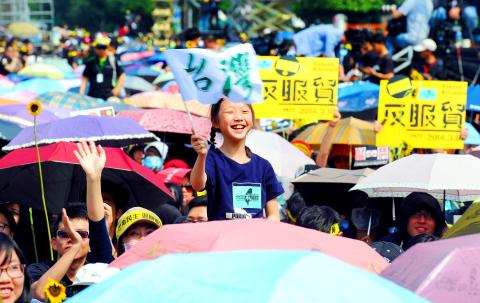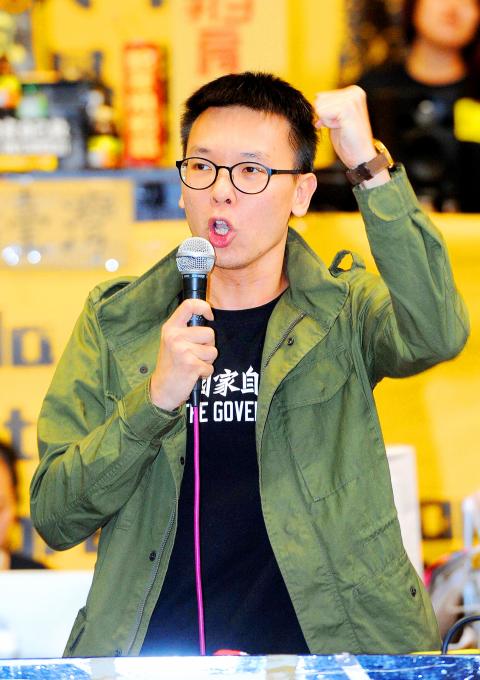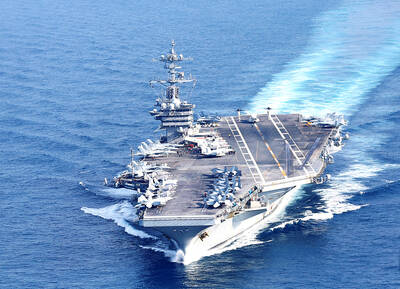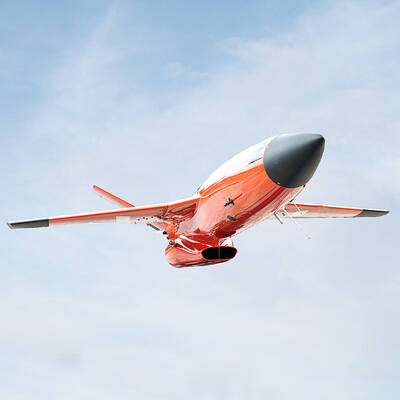The strong showing at the mass protest in front of the Presidential Office Building in Taipei yesterday has given the students who have been occupying the legislative floor for 13 days the confidence to continue their fight for Taiwan’s democracy, they said.
After protest leader Lin Fei-fan (林飛帆) announced that the number of protesters had surpassed 350,000 — and later surpassed 500,000 — a loud cheer erupted in the legislative chamber, which has been occupied by about 200 students since March 18.
“500,000 people have spoken. President Ma Ying-jeou (馬英九), do you still plan on hiding? 500,000 people demand your positive response,” Lin said.

Photo: Sam Yeh. AFP
The protest, a collaboration with civic groups, was the first time since the “Sunflower student movement” began that the students tried to actively bring in outside help.
The protest appeared to gain support after President Ma Ying-jeou (馬英九) rejected the demands the students made in a press conference on Saturday.
Ma conditionally agreed to establish a legislative monitoring mechanism on future cross-strait agreements, but rejected the organization of a citizens’ constitutional conference and the withdrawal of the controversial service trade pact, saying that the monitoring mechanism and the trade pact should be separate issues.

Photo: Wang Min-wei, Taipei Times
The movement’s leadership planned to organize the mass protest on Ketagalan Boulevard to apply pressure to Ma, but asked the students and protesters to head back to the Legislative Yuan compound, which is a few hundred meters from Ketagalan Boulevard, after the scheduled conclusion of the protest at 7pm to continue the original protest.
The leadership’s fear of a lack of manpower was never a concern with protesters packing every road near the Legislative Yuan — Ketagalan Boulevard, Zhongshan S Rd, Zhinan Rd, Qingdao E Rd and Linsen S Rd.
As the mass rally went on in front of the Presidential Office Building, students in the chamber conducted video teleconferences with foreign students who supported their movement in simultaneous rallies in Japan, Hong Kong and Australia.
Outside the Legislative Yuan compound, scheduled activities — including speeches, music performances and movie screenings, went on at Qingdao E Rd and Zhinan Rd, with students at both places watching a live broadcast of the major rally a few blocks away from giant TV screens.
Students returned to the Legislative Yuan compound after the rally ended at about 7:45pm, as members of the public headed home with no major conflicts reported.

CROSS-STRAIT COLLABORATION: The new KMT chairwoman expressed interest in meeting the Chinese president from the start, but she’ll have to pay to get in Beijing allegedly agreed to let Chinese Nationalist Party (KMT) Chairwoman Cheng Li-wun (鄭麗文) meet with Chinese President Xi Jinping (習近平) around the Lunar New Year holiday next year on three conditions, including that the KMT block Taiwan’s arms purchases, a source said yesterday. Cheng has expressed interest in meeting Xi since she won the KMT’s chairmanship election in October. A source, speaking on condition of anonymity, said a consensus on a meeting was allegedly reached after two KMT vice chairmen visited China’s Taiwan Affairs Office Director Song Tao (宋濤) in China last month. Beijing allegedly gave the KMT three conditions it had to

STAYING ALERT: China this week deployed its largest maritime show of force to date in the region, prompting concern in Taipei and Tokyo, which Beijing has brushed off Deterring conflict over Taiwan is a priority, the White House said in its National Security Strategy published yesterday, which also called on Japan and South Korea to increase their defense spending to help protect the first island chain. Taiwan is strategically positioned between Northeast and Southeast Asia, and provides direct access to the second island chain, with one-third of global shipping passing through the South China Sea, the report said. Given the implications for the US economy, along with Taiwan’s dominance in semiconductors, “deterring a conflict over Taiwan, ideally by preserving military overmatch, is a priority,” it said. However, the strategy also reiterated

‘BALANCE OF POWER’: Hegseth said that the US did not want to ‘strangle’ China, but to ensure that none of Washington’s allies would be vulnerable to military aggression Washington has no intention of changing the “status quo” in the Taiwan Strait, US Secretary of Defense Pete Hegseth said on Saturday, adding that one of the US military’s main priorities is to deter China “through strength, not through confrontation.” Speaking at the annual Reagan National Defense Forum in Simi Valley, California, Hegseth outlined the US Department of Defense’s priorities under US President Donald Trump. “First, defending the US homeland and our hemisphere. Second, deterring China through strength, not confrontation. Third, increased burden sharing for us, allies and partners. And fourth, supercharging the US defense industrial base,” he said. US-China relations under

The Chien Feng IV (勁蜂, Mighty Hornet) loitering munition is on track to enter flight tests next month in connection with potential adoption by Taiwanese and US armed forces, a government source said yesterday. The kamikaze drone, which boasts a range of 1,000km, debuted at the Taipei Aerospace and Defense Technology Exhibition in September, the official said on condition of anonymity. The Chungshan Institute of Science and Technology and US-based Kratos Defense jointly developed the platform by leveraging the engine and airframe of the latter’s MQM-178 Firejet target drone, they said. The uncrewed aerial vehicle is designed to utilize an artificial intelligence computer